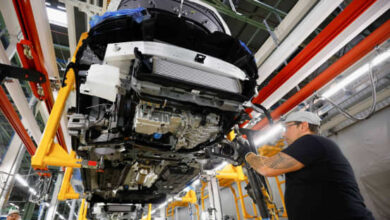Paris Olympics kick off with lavish opening ceremony
The Paris Olympics kicked off with a lavish opening ceremony Friday night as a flotilla of boats carried 10,500 athletes along the Seine — the first outdoor edition of an event expected to be watched by a billion people.
A shadow had been cast over the event by an act of criminal vandalism hit France’s high-speed rail network in the early morning, causing traffic chaos across the country. Then heavy rain began falling about 30 minutes into the three-hour performance, a nightmare scenario for those planning the theatrical spectacle that featured a huge cast of dancers, two orchestras and a gaggle of pop stars, including Lady Gaga singing a cabaret-inflected song.
“We are ready for this great event,” Interior Minister Gérald Darmanin said ahead of the ceremony, adding that no specific threats had been detected. The railway sabotage would “have no direct consequences for Olympic or ceremony”.

By mid-afternoon, long lines of ticket buyers had formed to enter the heavily guarded area along the Seine, where 320,000 spectators were expected to line the medieval cobblestone piers. The format of the event required tight security:45,000 police have been deployed on land and in the air, using helicopters, drones and snipers positioned on rooftops.
The weather also tested the dozens of experienced boat captains who steered the parade, who navigated at precise speeds to keep the show on schedule. Some spectators ran off the docks to seek shelter as the rain poured down.
President Emmanuel Macron hosted more than 100 heads of state at the Trocadero across the river from the Eiffel Tower, where athletes disembarked for the final parade and a performance by beloved French singer Céline Dion. Jill Biden, the wife of the US president, and other leaders attended a reception at the Elysée Palace beforehand.

The idea for such an ambitious opening was the brainchild of one man, Thierry Reboul, an events expert known for his slick marketing stunts, but to pull it off required more than 15,000 performers, technicians and pyrotechnicians.
The show featured ballet dancers on the roof of the Louvre, while hundreds of modern and break dancers performed along the piers and on several boats. The performers wore handmade costumes made by French fashion designers, and LVMH’s Louis Vuitton suitcases were prominently displayed in a long segment. Bernard Arnault’s LVMH is a sponsor of the Games.
Organizers had to cut back on some elements, such as BMX riders performing stunts on ramps because the rain made the roads too slippery.

When Reboul came up with the idea for the ceremony on the river Tony EstanguetThe head of the Paris organizing committee, a two-time gold medalist, reacted with shock that quickly turned to enthusiasm. “It was going to be ambitious, daring and completely crazy,” Estanguet said, recalling the moment.
Reboul said the idea came to him while walking along the Seine, the winding river whose banks were chosen by a Gallic tribe called the Parisii to establish a settlement some two thousand years ago. He said to himself: “It has to be here, of course it has to be here, and nowhere else.”
Organizers hired Thomas Jolly, a 42-year-old stage director best known for a musical called Crazy Starwho began to imagine how to convey the spirit of France from literature and culture to history. “I’m used to designing stage performances, and this time the whole city is my canvas,” he told reporters earlier this week.

Jolly hired a team he’d worked with for years — a music director, choreographer, and costume designer, all renowned in their fields — and also included author Leila Slimani, screenwriter Fanny Herrero, who created the show. Call my agent!, and others helped him paint the 12 paintings that made up the ceremony.
Before starting to write, they took a walk along the Seine for inspiration and researched the history of the river bridges, such as the oldest bridge, Pont Neuf, completed under King Henry IV in 1607, and the Pont d’Austerlitz, commissioned by Napoleon Bonaparte, where the parade would begin.
“We have exploited the past of each site and monument: almost every stone tells something about the history of France, the history of Paris, a history that is linked to the world,” he said.
But Jolly and Estanguet didn’t want the drama to overwhelm the athletes, instead putting them front and center by giving them the best spots to watch the show—the decks of boats on the river.
“The athletes are the heroes of the program,” Estanguet said.
Although officials have remained vague about the price tag, French media reported that the ceremony cost around 120 million euros, about four times the cost of the 2012 London Olympics opening ceremony. The total cost of the Paris Games, which are considered a greener affair because little new infrastructure is being built, is expected to be 9-10 billion euros, according to the national auditor. About a third of that will be covered by sponsors.
Jolly’s show is filled with memorable and cheesy moments: a hooded figure leaping across the zinc rooftops of Paris, drag queens dancing to electro music, royals being beheaded during the French Revolution to heavy metal, and a silver horse with a rider in armour gliding down the Seine.

Cheers rang out as beloved French footballer Zinedine Zidane passed the torch to tennis champion Rafel Nadal.
The spectacle culminates with an elaborate light show projected from the Eiffel Tower before the final flame is carried to the Louvre Museum, leading to a hot air balloon rising into the night sky carrying the flaming Olympic cauldron.
Surrounded by the Eiffel Tower, Canadian singer Céline Dion, in her first performance in years due to illness and wearing a white beaded dress with 500m of fringe designed by Dior, sang Edith Piaf’s song. Hymn of love.
“I declare the Paris Olympics open,” Macron said.
Additional reporting by Adrienne Klasa




